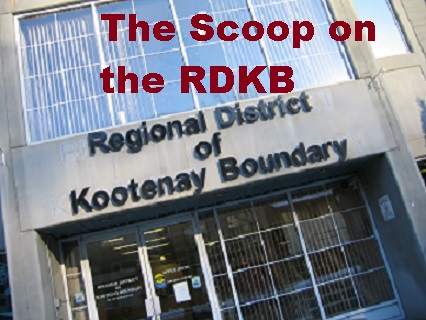A More Collaborative RDKB Board?
The Scoop on the RDBK: First Instalment
We property owners all pay money to the Regional District of Kootenay Boundary (RDKB). If you check your property tax bill, you’ll see an amount for a “Regional District Levy“. Mine is only $353, because I live in a tiny house. Yours is probably more. Where does it go? I decided to begin attending RDBK meetings to find out — and share with anyone who cares enough to wade through my reports.
The inaugural meeting of the new RDKB board was held in the Trail RDBK boardroom on December 11, and I rode down with Rossland’s representative to the board — to avoid causing unnecessary greenhouse gas (GHG) emissions, on the principle that every little bit of GHG hurts all of us, by exacerbating climate change. (That’s why I walk to town for my groceries and other errands instead of driving, aside from the fact that walking is so much better for my body.)
The inaugural meeting dealt only with matters such as administering the oath (or affirmation) of office, having Larry Doell take photos of all the board members, electing the board chair and vice-chair, voting on the choice of financial institution (CIBC) and auditor (Soligo & Associates), and giving the new board members some administrative information.
Who are the RDBK board members now?
Area A: Ali Grieve (rural Fruitvale – Montrose area);
Area B: Linda Worley (rural Greater Rossland, officially “Lower Columbia – Old Glory”) — elected board vice-chair;
Area C: Grace McGregor (Christina Lake) — board chair by acclamation;
Area D: Roly Russell (rural Grand Forks);
Area E: Vicki Gee (West Boundary);
Village of Midway: Marguerite Rotvold;
City of Greenwood: Ed Smith;
City of Grand Forks: Neil Krog;
City of Rossland: Kathy Moore;
Village of Warfield: Ted Pahl;
City of Trail: Mike Martin;
Village of Montrose: Joe Danchuck;
Village of Fruitvale: Patricia Cecchini.
About that money: how much are they paid?
It depends on whether the director is a rural area representative, or a municipal representative. A municipal rep is paid a stipend of $750 per month, plus an additional $83 per meeting (board or committee) that he or she attends, plus a $50 per month car allowance, plus mileage at 52 cents per kilometer. I had heard a rumour about a “tech allowance” but it turns out that is already inlcuded in the amount given for the stipend.
A rural area rep is paid all of that, plus an additional $1,074 per month, which makes a monthly stipend of $1,824 plus the other benefits.
The board chair receives an additional $1,911 per month, and the Vice-Chair receives an additional payment of $220 per month.
And the RDKB also pays for events such as the banquet (this one was at the Prestige Mountain Resort in Rossland) for staff and directors, that followed the inaugural meeting. This was described to me afterwards by one attendee as “a lavish spread, with an open bar.”
Why do the Area directors get paid so much more?
Area directors have no staff — they alone are responsible, each for representing his or her area with no other support. Obtaining input from their constituents requires more time and personal effort. The community representatives (this term, they are all mayors) receive remuneration for their duties in their own communities as well as the stipend they receive for being a director at the RDKB board table.
The RDBK Boardroom in Trail:
Tables are set up in a rectangle, with four very large electronic screens — like giant TV screens — set up in the middle, one facing each side of the rectangle. When I see how those are used, I’ll describe it to you. Each director has a microphone and is required to use it when speaking; the chair can control the “on” and “off” function of each mic. The room itself is spacious enough, with some seating at the back for members of the public to attend.
Heard in the Hallway:
During one of photography breaks, a gentleman told me that he was optimistic about this board, partly because a majority of its members are female — he said that in his experience, that tends to be a good thing. He also thought that more of the directors on this board tend to be more collaborative and less combative than in the past. We’ll see how accurate his assessment is.
Next up:
In January, the RDKB board will begin discussions on its budget of about $35 million. All of that money came from us, the taxpayers. Let’s see how this board decides to spend it. Stay tuned!
END


























